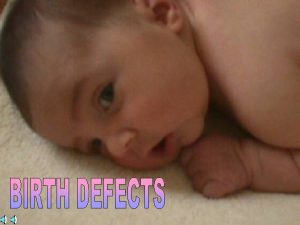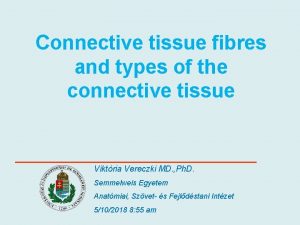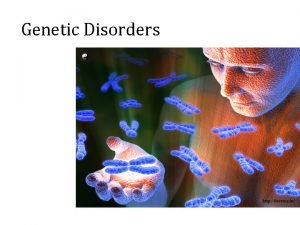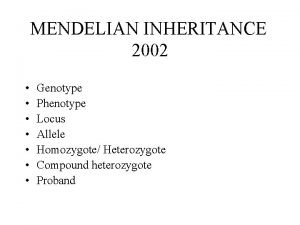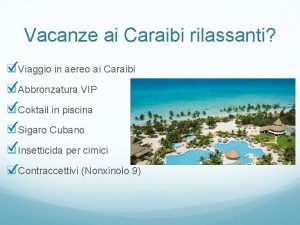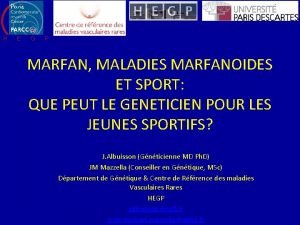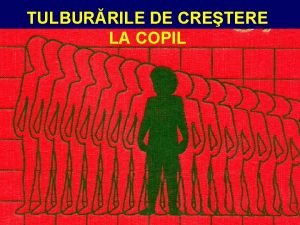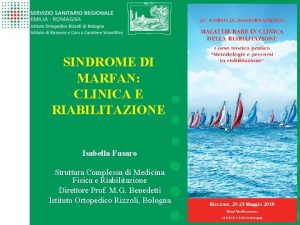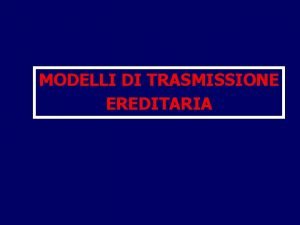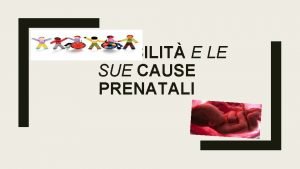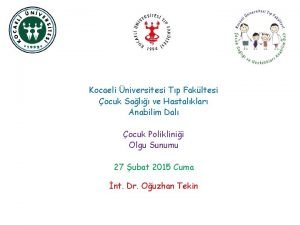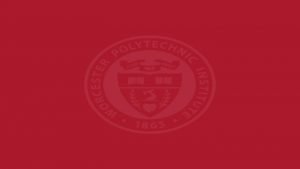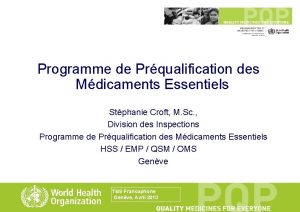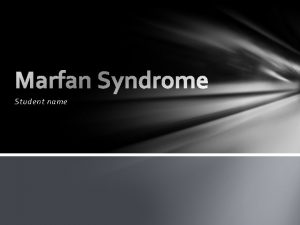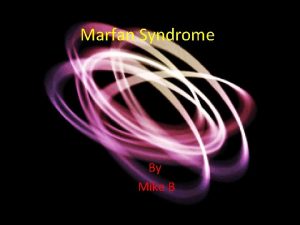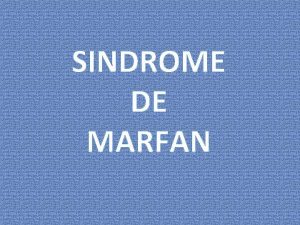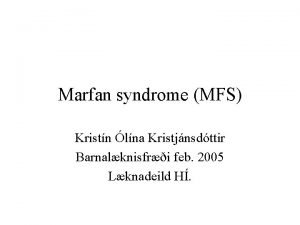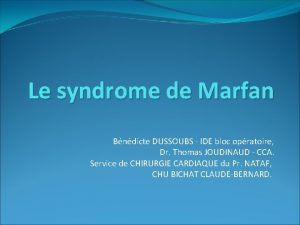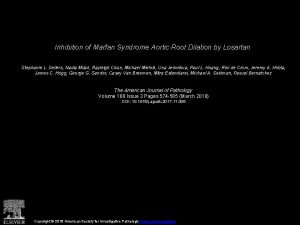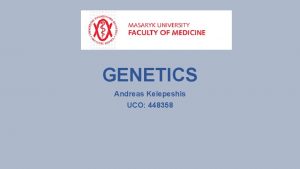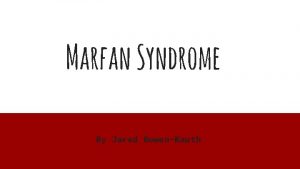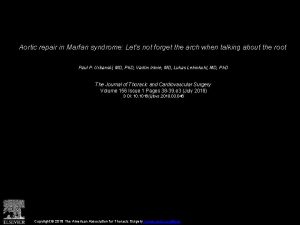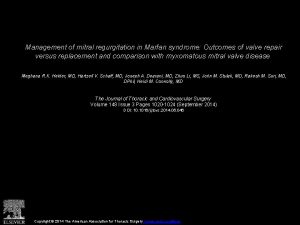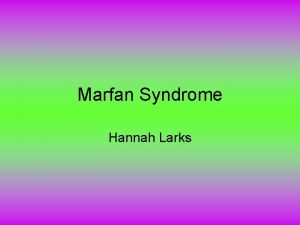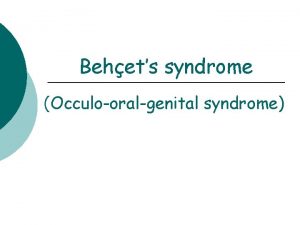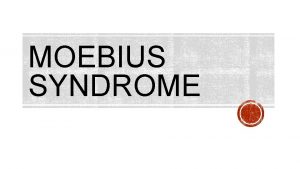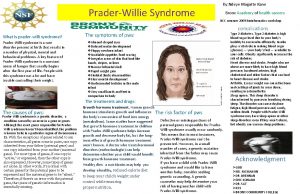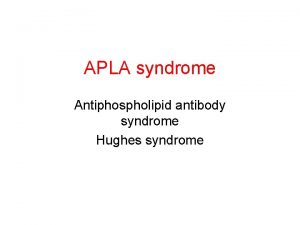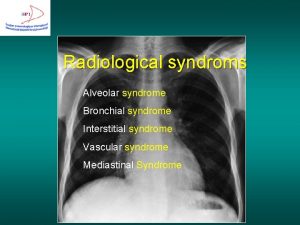Marfan Syndrome Stephanie van Colen DO Marfan Syndrome


























- Slides: 26

Marfan Syndrome Stephanie van Colen, DO

Marfan Syndrome n Marfan syndrome is an inherited connective tissue disorder n Autosomal dominant n Results from molecular defects in the fibrillin gene, (FBN 1) on chromosome 15 (q 15 -q 21) n Impaired structural integrity of the skeletal, ocular, and cardiovascular systems

Features Tall stature n Mitral-valve prolapse n Aortic-root dilatation n Aortic dissection n Pectus deformities n Occular problems - ectopia lentis n Joint laxity n Spinal deformities n

Pathophisiology n The affected gene encodes for the glycoprotein fibrillin: a major building block of microfibrils - structural components of the suspensory ligament of the lens - elastin in the aorta and other connective tissues

Pathophysiology n Abnormalities in the microfibrils - weaken the aortic wall Progressive aortic dilatation and possible aortic dissection secondary to tension caused by left ventricular ejection n Deficient fibrillin reduced structural integrity of the lens zonules, ligaments, lung airways, and spinal dura n

In patients with Marfan’s, the media is affected and has decreased tensile strength

Physical Findings The diagnosis of Marfan syndrome is mainly clinical n Skeletal findings n Taller/thinner stature n Limbs are disproportionately long compared with the trunk (dolichostenomelia) n Arachnodactyly n

Physical Findings n Major criteria include the following: n Pectus excavatum (severe)/ pectus carinatum n Reduced upper-to-lower body segment ratio n Arms and legs may be unusually long in proportion to the torso n Positive wrist (Walker) and thumb (Steinberg) signs n Scoliosis greater than 20°: > 60% of patients n Reduced extension of the elbows (<170°) n Medial displacement of medial malleolus - pes planus n Protrusio acetabula of any degree

Positive thumb (Steinberg) sign Positive wrist (Walker) sign


Physical Findings n Minor criteria are as follows: n n n n Pectus excavatum (moderate) Scoliosis less than 20° Thoracic lordosis Joint hypermobility Highly arched palate Dental crowding Typical facies (dolichocephaly, malar hypoplasia, enophthalmos, retrognathia, down-slanting palpebral fissures) For the skeletal system to be involved, need 2 major criteria or 1 major criterion plus 2 minor criteria

Other systems n Ocular findings: n The major criterion is ectopia lentis; @ 50% n n Pulmonary findings: n Minor criteria include the following: n n n Multiple other ocular findings Spontaneous pneumothorax (about 5%) Apical blebs Dural findings: n n 1 major criterion is defined: Dural ectasia (seen on CT / MRI) Seen in 65 -92%, usually in the lumbosacral spine Dural ectasia: ballooning / widening of the dural sac +/- herniation of the nerve root sleeves out of the foramina Less than 20% of patients have serious dural ectasia

Cardiovascular n Major criteria: n Aortic-root dilatation: ( 70 -80%) n Aortic dissections involving the ascending aorta n Minor criteria: n Mitral valve prolapse (55 -69%) n Dilatation of proximal main pulmonary artery without pulmonic stenosis or other cause n Calcification of mitral annulus (patients <40 y) n Dilatation of abdominal or descending thoracic aorta (patients <50 y) n For the CV system to be involved, need 1 minor criterion




Differential Ehlers-Danlos Syndrome n Fragile X syndrome n Gigantism and acromegaly n Hyperpituitarism n Hyperthyroidism n Klinefelter syndrome n

Echocardiography Diagnosis and management of aortic-root dilatation The upper limit of the normal aortic root size is 1. 9 cm/m 2 of body surface area n Assesses mitral-valve prolapse, LV size / function, LA size, and tricuspid valve function n TEE assesses the distal ascending and descending aorta and prosthetic valves n Doppler echocardiography - detecting and grading aortic and mitral regurgitation n

CT and MRI for assessing chronic dissection of the aorta - any patient who has an aortic-root dimension >150% of the mean for their body surface area or - ratio of actual to predicted aortic-root dimension >1. 5 n CT or MRI of the lumbosacral spine to evaluate for dural ectasia n

Treatment n Cardiovascular surgery CV surgery can substantially prolong survival Prophylactic / emergency CV surgery is needed for: - aortic and mitral regurgitation - aortic aneurysm - aortic dissection n In cases of acute proximal aortic dissection, emergency surgical replacement of the aortic root is performed n

Treatment The ascending aorta is usually replaced when the diameter exceeds 55 -60 mm n Composite valve-graft replacement is performed - prosthetic valve sewn into a tube graft with reimplantation of the coronary ostia (modified Bentall procedure) n Low rates of morbidity and mortality n

Treatment n n Bentall procedure Repair of Type A aortic dissection, aneurysm of the proximal ascending aorta, and aortoannular ectasia Replacement of the root and proximal ascending aorta with a tube graft containing a prosthetic valve and reimplantation of the coronary arteries into the graft Postoperative complications include: n leakage at the suture lines - pseudoaneurysm of the aortic or coronary anastomosis

Non-cardiac Treatment Scoliosis surgery n Pectus repair n Repair of pectus excavatum to improve respiratory mechanics n Pectus carinatum repair - mainly for cosmetic reasons n Pneumothorax therapy n Ocular therapy n Medical management n

Medical Management n Beta-blockers May delay aortic dilatation and progression to rupture or dissection. n The rate of surgical interventions has substantially declined during the past decade of beta-blockade use. n

Medical Treatment Anticoagulants are needed after artificial heart-valve placement n IV antibiotic therapy is required during cardiac and noncardiac procedures to prevent bacterial endocarditis n Progesterone and estrogen therapy have been used to induce puberty and reduce the patient's ultimate height - if tx is begun before puberty n

Referrences n n n Caffey’s Pediatric Diagnostic Imaging, Vol. 2, Kuhn, Slovis and Haller, Mosby, 2004. Thoracic Imaging, Webb, R. and Higgins, C. , Lippincott Williams & Wilkins, 2005. emedicine. com mayoclinic. org marfan. org
 Marfan syndrome face
Marfan syndrome face Type of connective tissue
Type of connective tissue Marfan syndrome genetics
Marfan syndrome genetics Leigh's disease
Leigh's disease Marfan syndrome
Marfan syndrome Locus
Locus Rickets x ray findings
Rickets x ray findings Marfan sign in rickets
Marfan sign in rickets Michael phelps síndrome marfan
Michael phelps síndrome marfan Aracnodactilia sindrome de marfan
Aracnodactilia sindrome de marfan Pterigium coli
Pterigium coli Sindrome di marfan
Sindrome di marfan Sindrome di marfan immagini
Sindrome di marfan immagini Sindrome di marfan
Sindrome di marfan Marfan sendromu
Marfan sendromu Evolve
Evolve Stephanie d wilson
Stephanie d wilson Myomics
Myomics Stephanie justine
Stephanie justine Stephanie kastely
Stephanie kastely Stephanie mansell
Stephanie mansell Stephanie ciccarelli
Stephanie ciccarelli Stephanie carnes
Stephanie carnes Wasteberg
Wasteberg Refraction
Refraction Stephanie croft
Stephanie croft Productive conversations take real empathy
Productive conversations take real empathy
